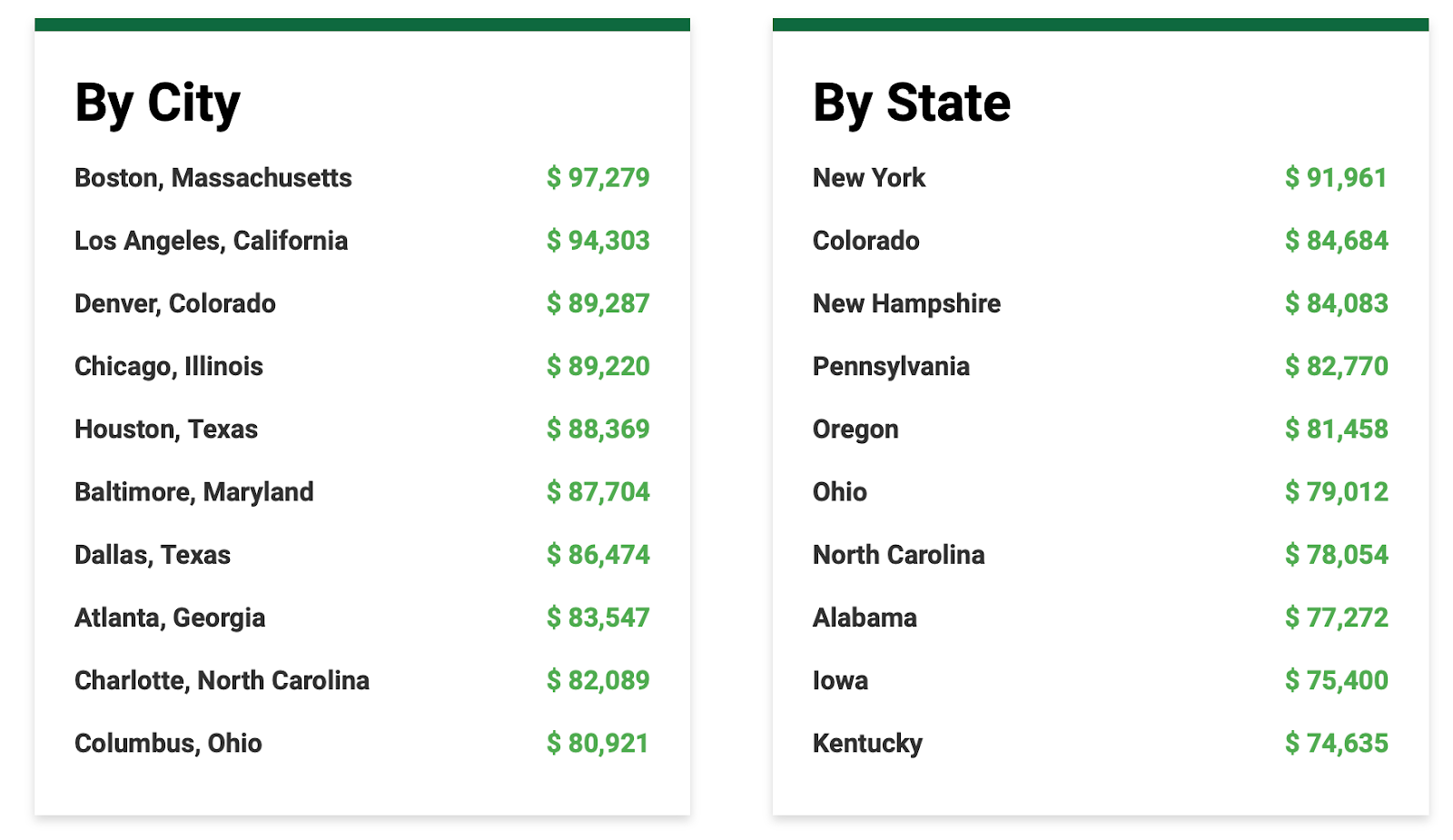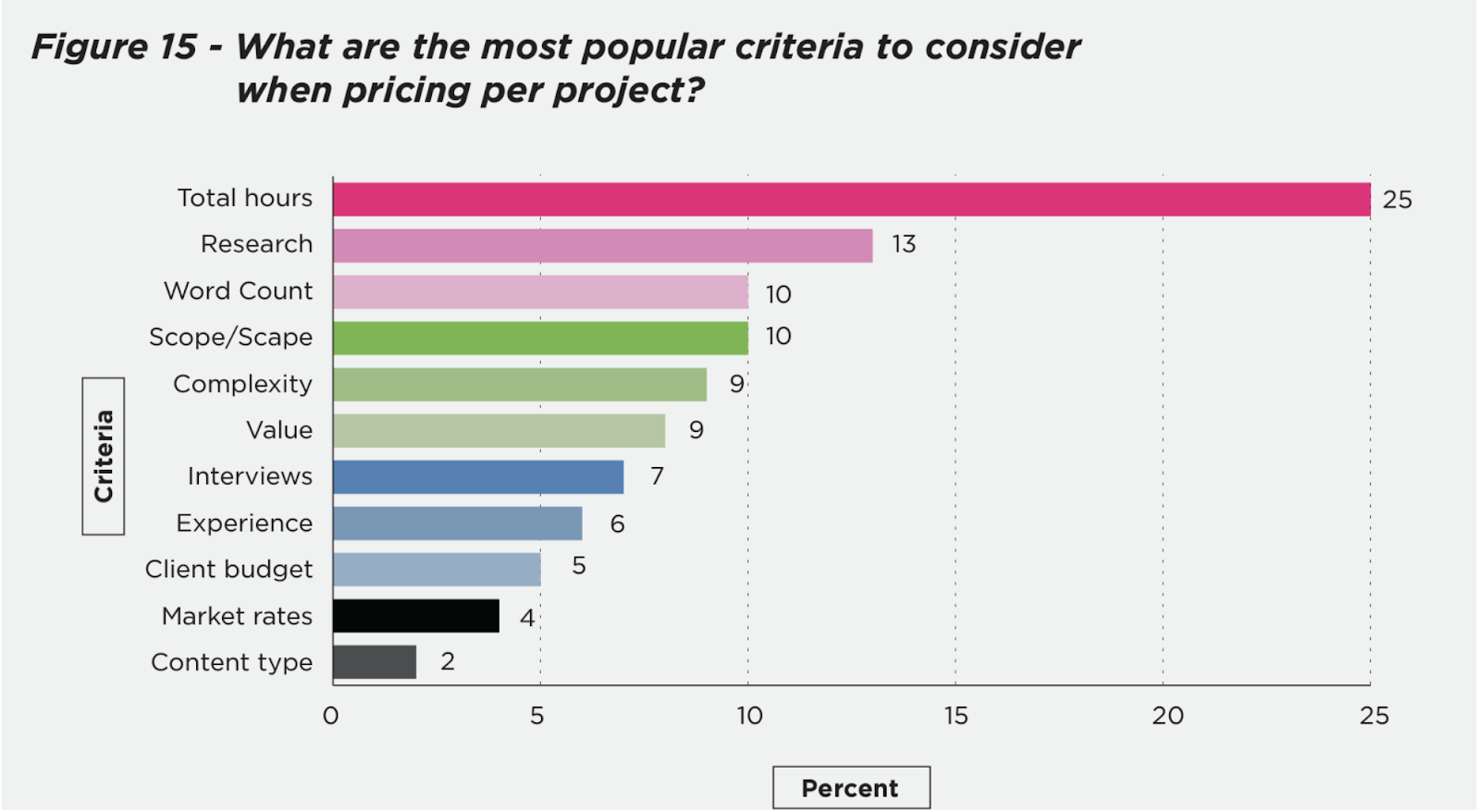Copywriter Earnings: What to Expect in 2025 and Beyond
Read about the key factors that influence a copywriter's salary, from experience level to location and niche. Learn how to set your rates effectively and increase your income as a copywriter in 2025.
October 7, 2025
October 7, 2025

So, you’re thinking about becoming a copywriter? A worthy choice of career. Copywriting is one of the most sought-after careers today. In fact, all communication-related jobs have seen a surge of around 25% in 2025, and the demand for human writing is still on the rise. Talk about artificial intelligence replacing us all, eh? Or perhaps you are already well into your writing career and are wondering if your income is fair and in line with industry standards? We've got you covered on both fronts — in this article, we'll break down what copywriters make in 2025 and help you chart a path to higher earnings.
Factors that affect copywriters' salaries
It's no secret that how much money a copywriter makes depends on a variety of factors. Let’s analyze some of the most significant ones that influence copywriting income. Before we begin, let's clarify one thing — we will have a lot of statistics in this section to make comparisons, and we will use the US as the reference point unless otherwise specified. Don't worry, we will also discuss other locations, but covering each aspect broken down by country would make this article way too long.
Experience level
Experience is one of the most significant factors in determining your salary, whether you are working as an in-house copywriter or a freelancer. More years of direct work experience typically lead to higher earning potential.

Here's how the average salary increases at different stages of a career, according to salary.com:
- Entry-Level (< 1 year) — $70,931
- Early Career (1-2 years) — $71,119
- Mid-Level (2-4 years) — $73,460
- Senior-Level (5-8 years) — $76,039
- Expert (over 8 years) — $76,223
It seems that the growth is not significant — only around $6,000 between a top-level and entry-level copywriter. Payscale has different gradations by years and salary levels:

Surely, each source may take into account other factors when considering these statistics, which we will discuss in a moment. These ranges are averages, and the actual numbers may vary considerably.
Don’t rush to spend money on copywriting courses at the beginning. Many free resources are available online. You can read blogs and watch free videos to learn. Instead of joining random courses, find an experienced copywriter who can guide you personally. You can book a one-on-one call with them, even if you have to pay a little. This way, you get advice that fits your needs and a clear plan to follow.
When starting:
- Learn the basics of writing that sells (persuasion).
- Practice writing every day.
- Create a simple set of writing samples (portfolio).
- Choose one topic to focus on, like health or finance. This helps you earn more.
{{Shambhavi Gupta}}
Location
Where you are physically located or which markets you work in makes a huge difference. Let's look at trends and benchmarks to understand what to expect in different regions. I have selected the top 10 countries based on their market share in the copywriting industry. For convenience, I used exchange rates converted to US dollars, rather than the rates in their national currency.
Copywriting income can vary even within a single country, especially in a large and diverse country like the United States, due to differences in local economies, industries, and the demand for marketing services. As a result, income levels can be highly uneven, even within the same geographic area.

Employment type
How you engage with your clients or employees plays a major role in determining how much you make as a copywriter. Of course, there are freelance copywriters who earn six figures and outperform in-house writers, and some companies pay more than others, so other factors should also be taken into account. However, let's look at the average situation on the market.
According to ZipRecruiter, the average freelance copywriter salary in the United States is $31 per hour, with a range between $24 and $67. In-house copywriters earn an average of $37 per hour, with a total income range between $14 and $67.

In-house roles often provide a sense of security and stability, with regular salaries and benefits such as health insurance and sick leave. However, these positions may not be as flexible, and the potential salary ceiling could be lower compared to freelance opportunities for top performers. Freelancing, on the other hand, gives you the freedom to be your own boss and decide what you want to write about. You can also set your own rates, which is great. However, there are some drawbacks to this. You are responsible for all aspects of your copywriting business, including health insurance, retirement contributions, and making sure you have a steady stream of income.
Here's a video from a professional copywriter who has done both, sharing their tips and advice on how to decide which path is right for you:
Niche
The industry or niche that you specialize in can have a huge say in your copywriting income. Certain industries, such as technology, law, finance, and medicine, are often more lucrative, as they require a deeper understanding of the field or technical knowledge. Therefore, you are hired for your expertise in these areas, not just your writing skills.
According to Wellfound, some of the highest-paying industries and their average salaries are as follows:
While the industries listed above may be highly paid, it's important to remember that they are not the only ones. In fact, every industry needs copywriters, and high-paying jobs can be found in any industry. The most important thing is to choose something that you feel confident about and that you truly enjoy working on.
Freelancers can sometimes earn more, especially when working with multiple clients in high-paying niches. In-house jobs give steady pay and benefits, but freelance work offers more freedom and potential for higher income if you find good clients. In my experience, health, finance, technology (like AI and SaaS), and legal/medical writing pay the highest rates. Specializing is super important because experts in these fields get paid much more than generalists.
{{Shambhavi Gupta}}
How to define your copywriting rates
Now that we have a better understanding of the current market situation, let's discuss some ways to determine how much you can charge and how to go about it.
One of the simplest ways to determine your copywriting rates for both in-house and freelance projects is by calculating your monthly expenses and desired income goal. You can use our freelance rate calculator to help you determine the right rate for your services.
Let's say you want to make money as a freelance copywriter. In this case, your monthly expenses would include not only personal expenses but also business-related expenses, taxes, health insurance, and retirement savings (in an ideal scenario). If your personal expenses, such as housing, food, healthcare, and other daily needs, total $2,000 per month, and your business-related expenses, including software subscriptions, taxes, and office equipment, amount to $1,500 per month, then you would need a minimum monthly income of $3,500 to cover all your expenses. To learn more about managing your income and expenses, please check out our Budgeting Tips for Freelancers article for more comprehensive strategies.
Now, let's move on from the general to the specific. When it comes to freelance copywriting, there are three pricing models to choose from.
- Per hour.
Around 40% of freelance copywriters charge a fixed rate per hour they work. This model is good for ongoing projects and working with clients who want full transparency and a clear understanding of the project's progress. According to Upwork, the average hourly rate copywriters make on their platform is:
- Entry-level: $20 —$30/hour
- Intermediate: $30 — $50/hour
- Expert: $50 — $150/hour
So, if your minimum monthly income goal is $3,500, as mentioned above, and you're considering working full-time, we need to divide this amount by 160 hours (40 hours per week multiplied by 4 weeks) to determine your hourly rate. In this case, it should be at least $22/hour. An entry-level rate, according to most statistics. But of course, if you want to charge more for your copywriting services, you can. This is just an example.

Pricing by the hour can be difficult because you’re limiting yourself to a certain number of hours to fit in with the quotation you’ve sent. If you need extra time for research, you can’t do it, which results in more revisions. I wouldn’t recommend pricing by the hour, but informing your pricing by project by tracking the time spent.
{{Ami Green}}
- Per project
According to a survey, most freelance writers (around 60%) choose this pricing model. And for a good reason — it's the most predictable and honest model if you're experienced enough to accurately estimate the scope of the project.

Bear in mind that when you charge per project, you are not just counting the writing but also factoring in research, your expertise, formatting, and the overall complexity of the project. The type and format of the work you produce directly affect the rates as well.

Let's take a look at the average rates for these types of work, as provided by the American Writers & Artists Institute (AWAI) in their 2025 State of the Industry report.
The full document lists 80 different copywriting services, which can be a helpful reference point and source of inspiration when determining your pricing and the types of projects you would like to work on as a copywriter. Please note, however, that these are rates for experienced US-based writers, not beginners.
- Per word
This is the least popular method for freelance writers to price their work, with only about 18% doing so. And the vast majority (97%) of the content they produce using this method is in the form of blog posts. This pricing model may be suitable for beginners, but experienced writers understand that they are paid for more than just words - the research, experience, and all other aspects of the work cannot be accurately measured by a simple word count. Plus, there is always a risk in taking a quantity-over-quality approach and severely underpricing yourself.
However, if you’d like to calculate your per-word rate, here’s how to do it: multiply your desired hourly rate by the number of words you can write in an hour, then divide that number by your target hourly rate. Sounds a bit confusing, I know, so here’s an example — if your hourly rate is $22 and you write 300 words per hour, then your per word rate is $0,07 ($22/300 words).

Pricing by the word is – in my opinion – not a great pricing model. “Just do it” would have given the copywriter next to nothing if they charged by word. It also puts the client in a doubtful frame of mind, convinced you’re waffling words just to charge more. For me, it’s not a sustainable and transparent method of pricing.
{{Ami Green}}
How to increase your copywriting income
Let's be honest — being a copywriter today is not just about putting words together. There are writers who make six figures and more, and they do much more than just write. They think like strategists and are valuable parts of businesses. You too can become one. Here's how you can increase your copywriting income:
1. Build a personal brand. Create an outstanding portfolio, build a website, and actively engage in social media to enhance your credibility. As you become more visible, people will be more willing to work with you and view you as a trusted professional, rather than simply a service provider.
For example, Emily, a UX writer who was featured on the Career Strategy Lab podcast, doubled her freelance rate and landed a full-time position as a UX writer after redesigning her portfolio and personal website. She presented herself as a strategic partner rather than just a writer, emphasizing the real business outcomes of her work, rather than just deliverables. This helped her attract high-quality clients who recognized her expertise in improving user experience and boosting conversion rates.
2. Upskill. Top writers charge for their expertise in various areas related to copywriting. Study SEO, digital marketing, UX writing, and AI tools to create more specific and complex services and charge higher fees for them.

3. Niche down. The narrower you go, the more opportunities you have to get higher rates. If you choose to specialize in some of the most lucrative niches, like tech, e-commerce, SaaS, finance or crypto, you will gain a deep understanding of your clients' problems, goals, and how to help them achieve them. This way, you can offer high-impact solutions that will allow you to charge premium rates for your specialized knowledge.
4. Create digital products. Once you have established your expertise and built a strong personal brand, you can monetize your skills and knowledge. Create templates, mini-courses, guides, toolkits, or newsletters to share your insights and earn income from them.
Copywriter earnings have gone up a lot for those who learn new skills and show off their work online. If you only call yourself a copywriter and do nothing else, there are too many others like you, especially now, with AI making it easy. But if you improve your skills and build a personal brand, companies are more likely to pay you higher rates. A beginner copywriter in India usually gets ₹2 to ₹3 lakh per year. With experience, that can go up to ₹10 lakh or more. The best earners get noticed because they share their work and ideas on platforms like LinkedIn, Medium, and Quora. This is how clients find and trust them, even with lots of competition. So, if you want better projects and pay, don’t just sit quietly. Learn, improve, and post about your work regularly so people know who you are.
{{Shambhavi Gupta}}
Make sure you review your rates at least once a year and ensure they are in line with industry standards and your experience. After all, it's not just about the rates you raise, it's about the value you bring to the table and the way you bring it.
What’s Next for Copywriters
In short: a lot of things. The future of copywriting is evolving fast, and UX writing and AI-assisted creativity are leading the way. According to the UX Content Collective 2024 Industry Report, the median salary for UX writers and content designers has reached around $110,000 a year, while freelancers in this field now charge an average of $70 –$ 80 per hour.
Meanwhile, 71% of freelance writers use AI tools to boost productivity and research, as shown in the State of Freelance Writing Report. The AI-powered copy market, valued at $1.9 billion in 2024, is projected to hit $17 billion by 2033.
Writers who combine creativity, UX insight, and smart use of AI won’t just keep up — they’ll lead the next era of freelancing.
Conclusion
How much money a copywriter can make depends on several factors. To determine the right rate, it's important to understand your income goals, the market in which you work, and the types of projects you wish to work on. And most importantly — to know your own worth, continuously develop your skills and position yourself as an expert in your field. Even if you're just starting out, staying up-to-date with industry trends and honing your skillset will help you charge fair and sustainable rates, leading to a steady increase in your income.
FAQ
We are here to ease your working routine
Whether you're freelancing or a full-time contractor, we simplify the working process, putting you in control.
Try it free



Discover how much a no-code developer makes, get insights about the career and its market, and get tips from specialists on how to get started.

Learn what media buyers do, average salaries in 2025, global rates, payment models, and how to increase your income in this role.

A clear guide to ghostwriter earnings: pricing models, real rates, key factors, and how to set fair, sustainable prices for your work.

.avif)